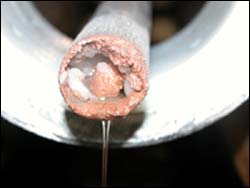Greenland ice core project yields probable ancient plant remains

The sediment sampler was hammered into the ground under the ice in order to recover sediment samples. It is here filled with a mixture of mud and ice.
A team of international researchers working on the North Greenland Ice Core Project recently recovered what appear to be plant remnants nearly two miles below the surface between the bottom of the glacial ice and the bedrock.
Researchers from the project, known as NGRIP, said particles found in clumps of reddish material recovered from the frozen, muddy ice in late July look like pine needles, bark or blades of grass. Thought to date to several million years ago before the last ice age during the Pleistocene epoch smothered Greenland, the material will be analyzed in several laboratories, said researchers.
The suspected plant material under about 10,400 feet of ice indicates the Greenland Ice Sheet “formed very fast,” said NGRIP project leader Dorthe Dahl-Jensen, a professor at the University of Copenhagen’s Niels Bohr Institute. “There is a big possibility that this material is several million years old — from a time when trees covered Greenland,” she said.
“Several of the pieces look very much like blades of grass or pine needles,” said University of Colorado at Boulder geological sciences Professor James White, a NGRIP principal investigator. “If confirmed, this will be the first organic material ever recovered from a deep ice-core drilling project,” said White, also a fellow of CU-Boulder’s Institute of Arctic and Alpine Research.
The ice cores in which the reddish material was found also contain a high content of trapped gas, which is expected to help researchers determine what the area’s climate history was like on an annual basis during the past 123,000 years. Each yearly record of ice can reveal past temperatures and precipitation levels, the content of ancient atmospheres and even evidence for the timing, direction and magnitude of distant storms, fires and volcanic eruptions, said White.
NGRIP is an international project with participants from Denmark, Germany, Japan, the United States, Switzerland, France, Sweden, Belgium and Iceland. NGRIP is funded by the participating countries, including the U.S. National Science Foundation. The cores from NGRIP are cylinders of ice four inches in diameter that were brought to the surface in 11.5-foot lengths. Developed by the NGRIP research team, the specialized deep ice drill has been used to bore several deep ice cores.
The NGRIP drilling site is located roughly in the middle of Greenland at an elevation of about 9,850 feet. The temperature in the subsurface trenches where ice-core scientists worked is minus 22 degrees Fahrenheit. CU-Boulder doctoral student Trevor Popp of INSTAAR was the lead driller on the 2004 NGRIP effort. Another CU-Boulder graduate student, Annalisa Schilla, also participated in the 2004 NGRIP field season.
Media Contact
More Information:
http://www.colorado.eduAll latest news from the category: Earth Sciences
Earth Sciences (also referred to as Geosciences), which deals with basic issues surrounding our planet, plays a vital role in the area of energy and raw materials supply.
Earth Sciences comprises subjects such as geology, geography, geological informatics, paleontology, mineralogy, petrography, crystallography, geophysics, geodesy, glaciology, cartography, photogrammetry, meteorology and seismology, early-warning systems, earthquake research and polar research.
Newest articles

Parallel Paths: Understanding Malaria Resistance in Chimpanzees and Humans
The closest relatives of humans adapt genetically to habitats and infections Survival of the Fittest: Genetic Adaptations Uncovered in Chimpanzees Görlitz, 10.01.2025. Chimpanzees have genetic adaptations that help them survive…

You are What You Eat—Stanford Study Links Fiber to Anti-Cancer Gene Modulation
The Fiber Gap: A Growing Concern in American Diets Fiber is well known to be an important part of a healthy diet, yet less than 10% of Americans eat the minimum recommended…

Trust Your Gut—RNA-Protein Discovery for Better Immunity
HIRI researchers uncover control mechanisms of polysaccharide utilization in Bacteroides thetaiotaomicron. Researchers at the Helmholtz Institute for RNA-based Infection Research (HIRI) and the Julius-Maximilians-Universität (JMU) in Würzburg have identified a…



